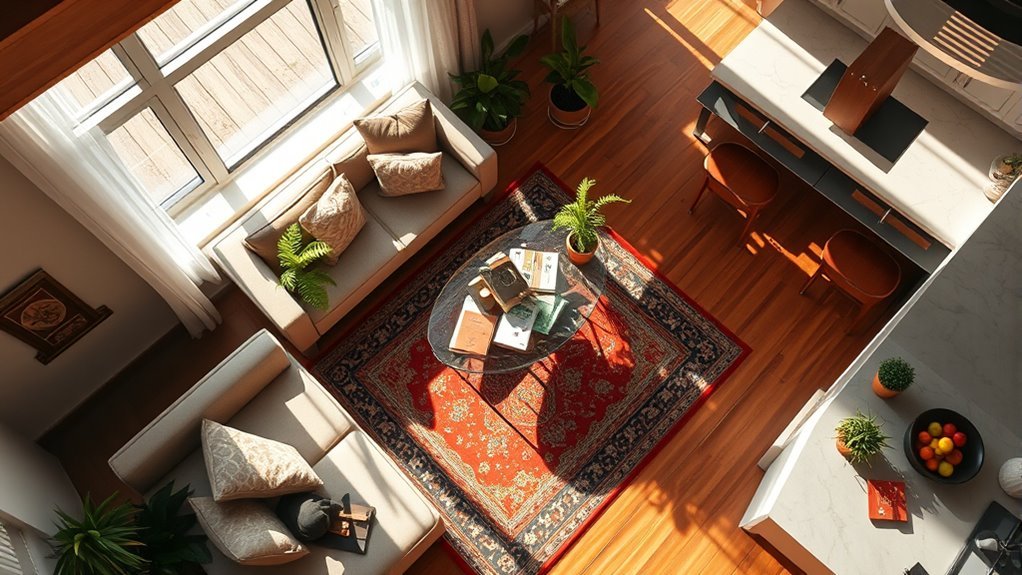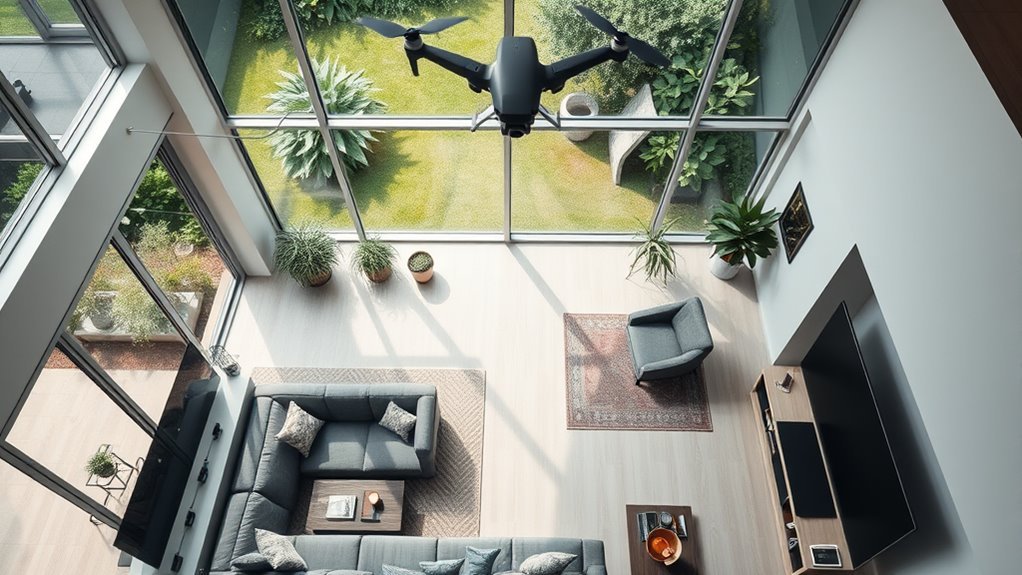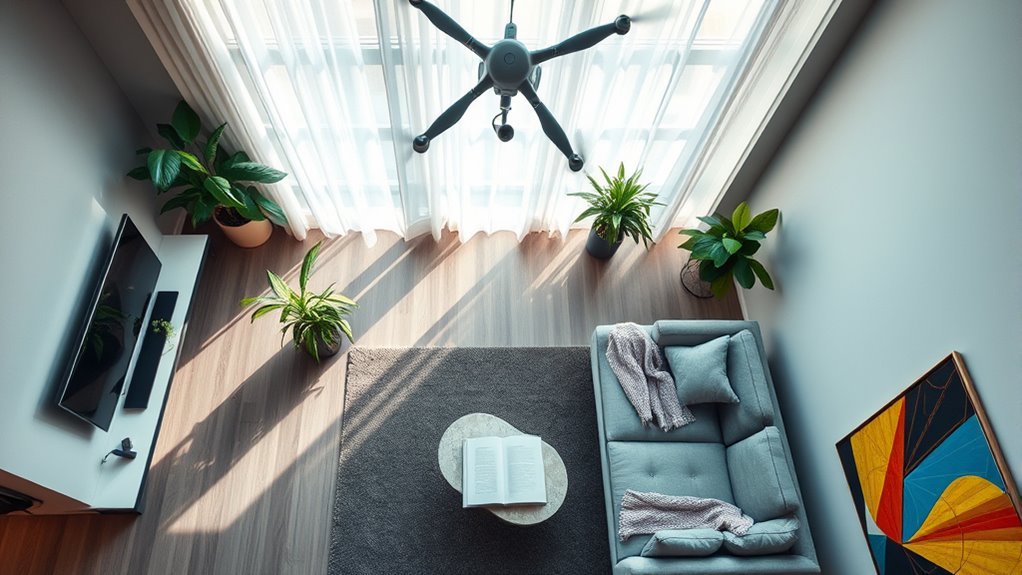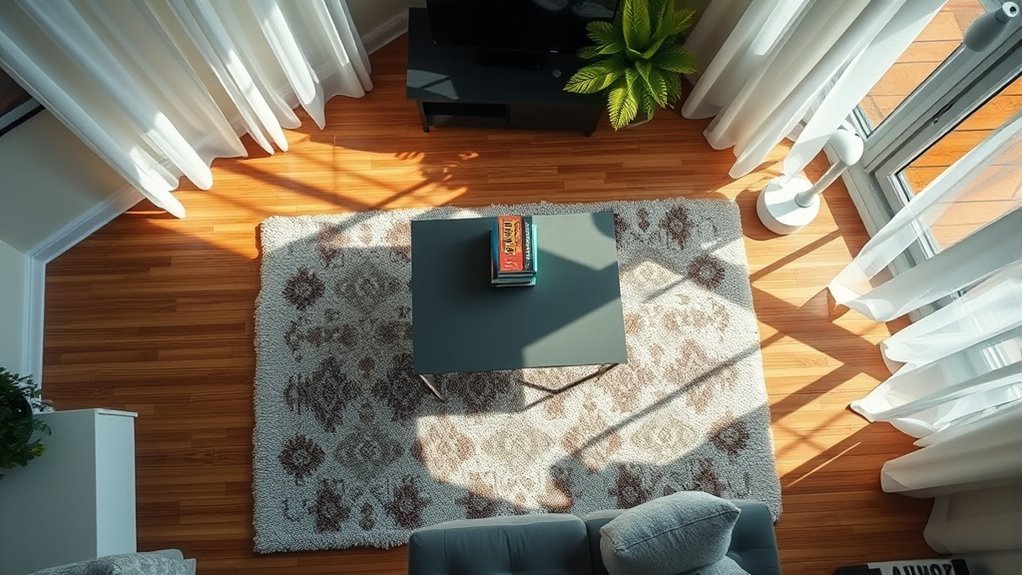Drones equipped with high-resolution cameras and sensors can capture detailed images and videos inside your home, making your personal space vulnerable to unwanted surveillance. Depending on the drone’s capabilities, it might detect heat signatures or record video without your knowledge. This raises significant privacy concerns and highlights the need for understanding legal boundaries. If you’re curious about how to protect yourself from such surveillance, there’s much more to explore on this topic.
Understanding Drone Technology and Capabilities

Drones, or unmanned aerial vehicles (UAVs), have revolutionized how we perceive and interact with our surroundings. One key aspect of this technology is the integration of advanced drone sensors, which enhance their capabilities. These sensors allow drones to collect high-resolution aerial imaging, providing detailed views of landscapes, structures, and even indoor environments. By leveraging thermal, optical, and multispectral sensors, drones can capture data that’s indispensable for various applications, from agriculture to real estate. This aerial imaging not only aids in surveillance but also empowers individuals to monitor their property and surroundings more effectively. Understanding these capabilities can help you utilize drones to their fullest potential, ensuring you maintain your freedom while staying informed about what’s happening around you. Additionally, high-precision sensors improve surveying accuracy in various environments, enhancing the overall effectiveness of drone applications. Moreover, the integration of NDAA compliance in camera technology ensures that drones operate within legal and security frameworks, contributing to safer monitoring practices.
Types of Drones and Their Surveillance Functions

In the domain of aerial surveillance, various types of drones cater to specific functions and operational needs. You’ll find quadcopters, commonly used for real-time video monitoring, thanks to their stability and maneuverability. Fixed-wing drones excel in covering larger areas, making them ideal for extensive property surveillance. Multirotor drones, on the other hand, are adept at hovering and capturing detailed images or videos from various angles. For thermal imaging, specialized drones equipped with infrared cameras can detect heat signatures, revealing potential intrusions or issues within your home. Each of these drone types serves distinct surveillance functions, allowing you to choose the right tool for your specific security requirements, ultimately enhancing your sense of freedom and safety in your own space. Additionally, some drones are designed to optimize fieldwork efficiency through advanced software, making them versatile for agricultural applications as well. Moreover, the integration of advanced gyroscopic stabilization in some drones ensures that footage remains steady and professional-looking, even in challenging environments.
Factors Affecting Drone Visibility

While evaluating how effectively drones can monitor your home, several factors come into play that can greatly impact their visibility. Drone altitude affects the overall field of view, while weather conditions like rain or fog can obscure visibility considerably. Camera resolution is essential for capturing detailed images, but it may be hindered by reflective surfaces or material density of your home’s exterior. The interior layout can create blind spots, especially within privacy zones. Light penetration also plays a significant role, as insufficient lighting can limit the drone’s effectiveness. Additionally, signal interference from structures or electronic devices can disrupt communication, impacting drone movements and surveillance capabilities. Understanding these elements is key to optimizing drone monitoring of your property.
What Drones Can See Inside Your Home
When considering what drones can see inside your home, privacy concerns become paramount. Their surveillance capabilities can capture detailed imagery and data, raising questions about how this information is used and who has access to it. Understanding these aspects is essential for maneuvering the implications of drone technology in residential areas.
Privacy Concerns
As drones become increasingly prevalent in residential areas, concerns about privacy intensify, particularly regarding what these devices can capture inside your home. The potential for drones to infringe upon your privacy rights raises critical questions about drone ethics. You might not realize that high-resolution cameras can see through windows, capturing intimate moments or private spaces without your consent. This intrusion challenges the boundaries of acceptable surveillance and poses significant legal and ethical dilemmas. As you navigate your daily life, consider the implications of drone technology on personal privacy. Advocating for robust privacy protections and regulations is essential to guarantee that your freedom remains intact, protecting you from unwanted observation and maintaining the sanctity of your private space.
Surveillance Capabilities
The surveillance capabilities of drones have advanced considerably, enabling them to capture detailed imagery and data from within residential spaces. Equipped with high-resolution cameras and sensors, drones can peer through windows, revealing layouts and activities in your home. This raises significant surveillance ethics concerns, as unauthorized monitoring infringes on personal privacy. You might not be aware that sophisticated drone detection systems are being developed to identify and mitigate such intrusions. These technologies can help protect your freedom by alerting you to unauthorized surveillance. As drone technology evolves, balancing its benefits with ethical considerations becomes essential. Understanding these capabilities empowers you to safeguard your privacy while traversing the complexities of modern surveillance.
Legal Implications of Drone Surveillance
Although drone technology offers significant advantages for various applications, its use for surveillance within private spaces raises complex legal issues. You need to be aware that drone laws vary greatly by jurisdiction, often conflicting with established privacy rights. For instance, many regions impose restrictions on flying drones over residential areas, aiming to protect individuals from unauthorized surveillance. Violating these laws can lead to severe penalties, including fines and criminal charges. It’s vital to understand that even if a drone is legally operated, capturing images or videos inside your property without consent could infringe on your privacy rights. The use of drones for surveillance must also consider signal attenuation challenges that can affect the quality of captured data. As drone usage expands, maneuvering through these legal frameworks becomes essential to safeguard both personal freedoms and technological advancements. Understanding federal oversight can help clarify the legal boundaries surrounding drone operations and privacy rights.
Privacy Concerns Surrounding Drone Usage
As drones become more integrated into everyday life, the risks of unwanted surveillance increase considerably. You might find yourself questioning the legal implications surrounding potential invasions of privacy, especially as drone technology advances. Understanding these concerns is essential for maneuvering the balance between innovation and personal privacy.
Unwanted Surveillance Risks
While drones offer impressive technological capabilities, they also pose significant privacy concerns that can’t be overlooked. With advanced drone technology, individuals can easily capture images and videos from your property without your consent, leading to potential privacy invasion. This unwanted surveillance can occur during both personal moments and routine activities, eroding the sense of security you might expect in your own home. Furthermore, as drones become more accessible, the risk of misuse escalates, allowing unauthorized users to exploit these devices for intrusive purposes. It’s essential to remain vigilant about how drone technology could infringe upon your privacy, prompting discussions about ethical usage and the need for protective measures to safeguard personal space in an increasingly monitored world.
Legal Implications of Invasion
Given the rapid proliferation of drone technology, understanding the legal implications surrounding their use is vital for protecting personal privacy. Drones can easily breach legal boundaries, leading to potential invasion of privacy. You must consider invasion ethics when evaluating where drones can fly and what they can observe. Many jurisdictions have enacted laws to regulate drone usage, but these vary greatly. Some laws are ambiguous, leaving room for interpretation, which can undermine your privacy rights. If a drone captures footage of your private space without consent, it may constitute illegal surveillance. As technology evolves, so must the legal frameworks governing it, ensuring that personal freedoms are respected while balancing innovation and privacy. Staying informed is essential.
How to Protect Your Privacy From Drones
To effectively safeguard your privacy from drones, it’s essential to understand the technologies and methods that can be employed for protection. One effective approach is drone shielding, which involves using materials or structures that obstruct a drone’s ability to capture images or video. You might consider installing privacy screens or employing specialized coatings that reflect or absorb drone signals. Additionally, utilizing privacy gadgets, such as signal jammers or drone detection systems, can provide further layers of security. These devices can alert you to an intruding drone, enabling swift action. By integrating these technologies into your home, you can greatly enhance your privacy and maintain control over your personal space in an increasingly surveilled world.
The Role of Legislation in Drone Regulation
As privacy concerns continue to grow alongside the proliferation of drones, the need for effective regulation becomes increasingly apparent. You should be aware that drone legislation varies considerably across jurisdictions, often leading to gaps in protection for personal privacy. Regulatory frameworks need to address the complexities of drone technology, balancing innovation with individual rights. Effective legislation can impose restrictions on where drones can operate, how they can capture images, and what data they can collect. By advocating for thorough drone legislation, you empower yourself and others to maintain privacy standards that reflect societal values. Transparency and accountability in regulatory frameworks are essential to guarantee drones enhance our lives without compromising our freedom and personal space.
Future Trends in Drone Technology and Privacy
While the rapid advancement of drone technology presents exciting opportunities, it also raises significant privacy implications that demand careful consideration. As emerging technologies enhance drone capabilities, you’ll find increased surveillance potential, making ethical considerations paramount. The ability to capture high-definition imagery and utilize AI for data analysis heightens concerns about unauthorized monitoring and data collection. Future trends may include stricter regulations to protect personal privacy while balancing innovation. You’ll need to stay informed about how these technologies evolve and the implications for your freedom. Advocating for transparent policies and ethical usage will be essential to guarantee that drone technology serves society without infringing on individual rights. Ultimately, striking a balance between innovation and privacy is critical for a free society. Moreover, understanding drone surveillance mechanisms is vital for advocating effective countermeasures against privacy violations. As AI-driven solutions continue to evolve, they will play a crucial role in ensuring that surveillance is conducted responsibly and ethically.
Frequently Asked Questions
Can Drones Penetrate Thick Walls or Barriers?
You might think drones can easily penetrate thick walls, but their capabilities are limited. Most drones can’t achieve wall penetration due to physical constraints, relying instead on external data gathering or line-of-sight for effective operation.
What Types of Cameras Are Used in Drones?
When exploring drone camera types, you’ll find options like RGB cameras for aerial photography, thermal cameras for heat detection, and multispectral cameras for agricultural analysis. Each type serves specific purposes, enhancing your aerial imaging capabilities considerably.
How Far Can Drones Transmit Video Footage?
Think of a bird soaring high; drones can transmit video footage up to several miles, depending on the signal range. Factors like interference and technology affect video transmission, determining how far you can connect and control.
Do Drones Have Night Vision Capabilities?
Yes, some drones are equipped with night vision technology, enhancing their drone surveillance capabilities. This allows you to monitor environments in low-light conditions, providing a significant advantage for security and situational awareness during nighttime operations.
Can Drones Detect Heat Signatures Inside Homes?
Drones equipped with heat detection technology can identify temperature variations, potentially revealing hidden occupants. With 60% of Americans concerned about privacy, understanding these capabilities is essential as they navigate the balance between surveillance and personal freedom.

